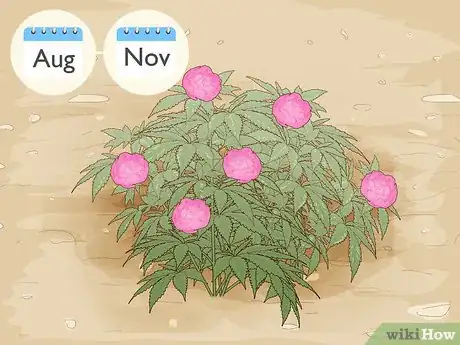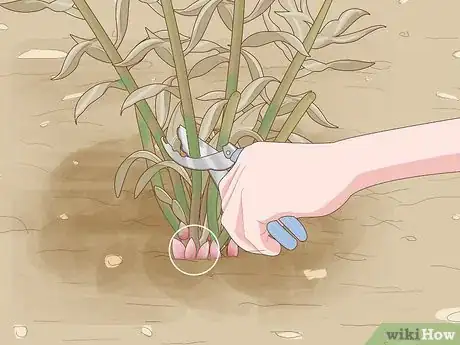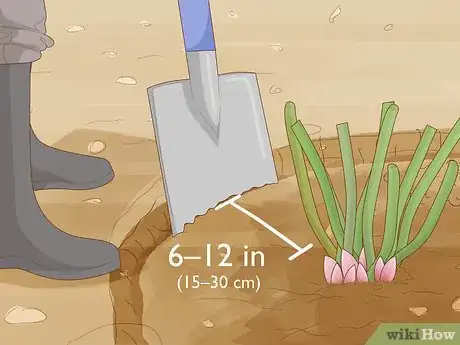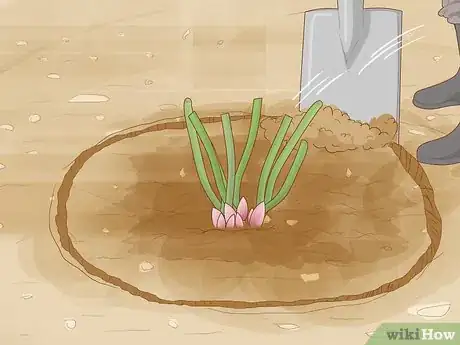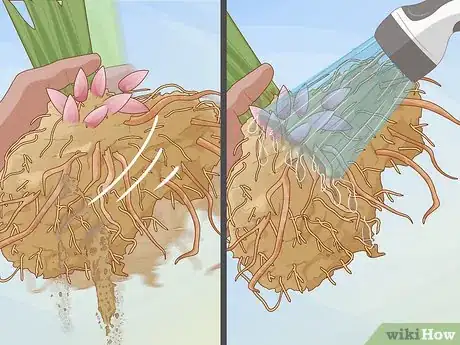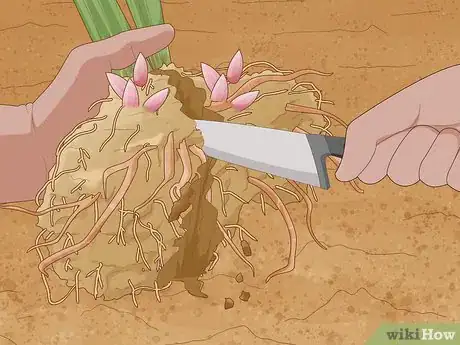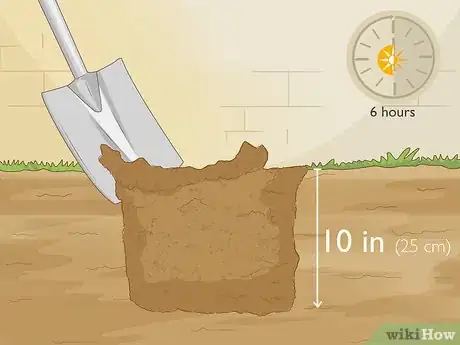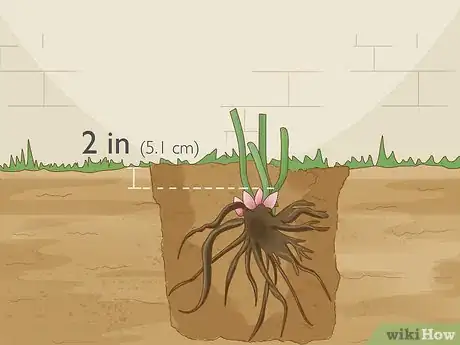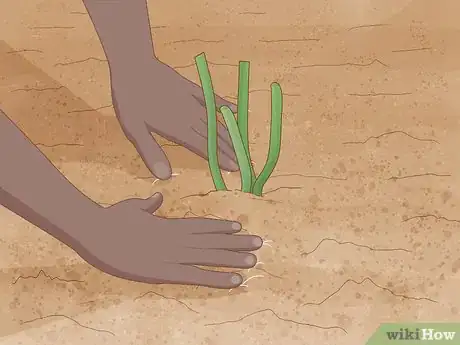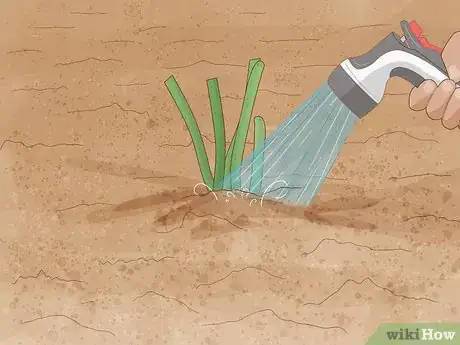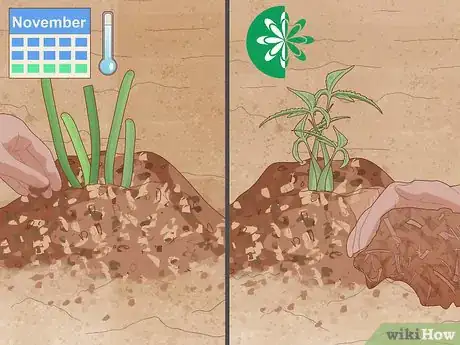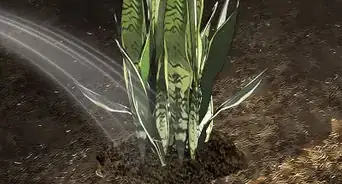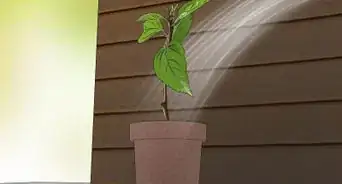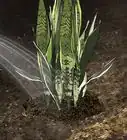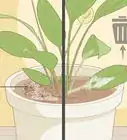This article was co-authored by wikiHow Staff. Our trained team of editors and researchers validate articles for accuracy and comprehensiveness. wikiHow's Content Management Team carefully monitors the work from our editorial staff to ensure that each article is backed by trusted research and meets our high quality standards.
There are 7 references cited in this article, which can be found at the bottom of the page.
wikiHow marks an article as reader-approved once it receives enough positive feedback. This article received 18 testimonials and 99% of readers who voted found it helpful, earning it our reader-approved status.
This article has been viewed 279,439 times.
Learn more...
Peonies are easy-to-grow perennial plants with a long lifespan. If you'd like to divide your peonies up and plant them in a different spot, make sure that spot has lots of sunlight and well-draining soil. When you divide the peonies, each section should have at least 3 buds and some healthy roots to promote regrowth. It's super important not to place the buds in the soil any deeper than 2 in (5.1 cm) when you go to replant them, or the peonies won't be able to create beautiful blooms in the spring.
Steps
Dividing Peonies
-
1Aim to transplant the peonies in the fall. This is when the plant will be dormant, making it safer to move it to another spot. Avoid transplanting peonies in the spring when they’re beginning to bloom.[1]
- August through the beginning of November is a safe period to transplant peonies.
-
2Trim away foliage to prepare the plant for new blooms. In the fall, the peony’s leaves will turn brown and wither. Use a pair of garden shears to cut the stems off near the base of the top of the root ball. You don’t need to keep any stems—as long as the root ball has buds or eyes on it, it will regrow.[2]
- If you’re transplanting your peonies in the spring, don’t cut the foliage off.
Advertisement -
3Dig 6–12 in (15–30 cm) from the peonies to avoid damaging the roots. If you dig too close to the plant, you could cut into important roots and damage the plant. Try digging a circle around the plant that’s at least 6 in (15 cm) away from the base to make sure the roots are safe.[3]
-
4Use a shovel or spade to loosen the root ball from the ground. Continue digging a circle around the peonies, loosening up the soil carefully. Loosen the soil until you can grasp the root ball gently and easily lift it from the ground.
- If you have to pull on the root ball to get it out of the soil, the roots and soil aren’t loose enough yet for it to be safely removed.
-
5Remove excess soil from the roots gently. Shake the plant gently to help extra soil fall off easily. You can also use a hose or watering can to spray the plant, washing the soil off of the roots.[4]
- Rinsing the plant will help you see the roots and buds so you can replant it correctly.
-
6Use a sharp knife to cut the plant into sections with 3-5 buds each. Separate the plant into sections so that each section will have 3-5 buds, or eyes, as well as a healthy portion of root system. Use the knife to cut the plant into as many sections as is necessary.
- The buds will look like small white or pink eyes on the root ball.
- If your peony plant only has 3-5 buds, it doesn’t need to be divided.
- Use a clean knife to prevent the plant from getting infected.
Transplanting the Peonies
-
1Choose a spot in full sun with well-draining soil to dig the hole. Peonies need at least 6 hours of sunlight each day, and nutrient-rich soil. Pick a spot in your yard that receives a good amount of light, and start digging the hole at least 10 in (25 cm) deep. To make the soil better for the peonies, you can mix in some compost or other organic matter if desired.[5]
- Mix 1 part organic matter with 2 parts regular soil for a healthy soil mix.
- If you’re transplanting more than one peony, space them out at least 3 ft (0.91 m) apart from each other to make sure the roots don’t intertwine.
-
2Place the root so that no more than 2 in (5.1 cm) of soil covers the buds. As you’re setting the root into your fresh soil, look for the pink eyes or buds. These shouldn’t be buried deeper than 2 in (5.1 cm) into the soil, or the plant won’t be able to bloom properly.
- If you place the root ball in the soil and notice the buds are too deep, take the root ball out and add more soil to the bottom of the hole until the root ball is at the right height.
- It’s better for the root ball to be placed too high in the ground than too low.
-
3Fill the hole in with soil and press it gently. Once the root ball is placed in the hole at the right height, fill in the hole with the nutrient-rich soil. Pat down the soil gently so that the roots are covered and the soil is in an even layer on the ground.[6]
- Use your shovel to fill in the hole, or use your hands to move the soil around the root ball.
-
4Water the plant well after it’s been transplanted. After your peonies are in their new homes, water the roots thoroughly once. After that, they will be able to thrive on the water that comes from rain showers.[7]
- If you aren’t getting much rain, water the peonies once a week until the ground freezes in the colder months.
-
5Add a layer of mulch in late November to prevent freezing and thawing. Spread 2–4 in (5.1–10.2 cm) of mulch onto the soil around the peonies to help keep the soil and roots healthy. Remove the mulch in the early spring so that the plant can begin to bloom.[8]
- If the soil and roots are constantly freezing and then thawing again, it’s going to damage the plant.
Community Q&A
-
QuestionCan peonies be dug up and divided in the spring?
 Community AnswerYes. Water the plant really well the day before, as that makes it come out easier.
Community AnswerYes. Water the plant really well the day before, as that makes it come out easier. -
QuestionDo peonies have seeds?
 Community AnswerAbsolutely. The seeds are inside the pods. Snip the pods off after they have bloomed and turned brown. Then, store them in a cool, dark place until you're ready to plant them.
Community AnswerAbsolutely. The seeds are inside the pods. Snip the pods off after they have bloomed and turned brown. Then, store them in a cool, dark place until you're ready to plant them. -
QuestionIf a peony plant has been stomped on, will it come back in the spring?
 Community AnswerThere are too many variables to this question, but in general, it is very hard to kill a well-established peony plant.
Community AnswerThere are too many variables to this question, but in general, it is very hard to kill a well-established peony plant.
References
- ↑ https://www.bhg.com/gardening/flowers/perennials/how-to-transplant-peonies/
- ↑ https://www.youtube.com/watch?v=wZGYU7-tErs#t=58s
- ↑ https://www.youtube.com/watch?v=7dAZ5o1vKsg#t=58s
- ↑ https://hortnews.extension.iastate.edu/1999/8-27-1999/transpeon.html
- ↑ https://www.youtube.com/watch?v=d5t0a9w8-5s#t=56s
- ↑ https://www.youtube.com/watch?v=d5t0a9w8-5s#t=2m40s
- ↑ https://www.youtube.com/watch?v=d5t0a9w8-5s#t=2m44s
- ↑ https://hortnews.extension.iastate.edu/1999/8-27-1999/transpeon.html
